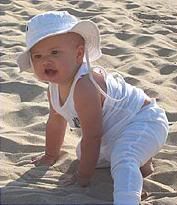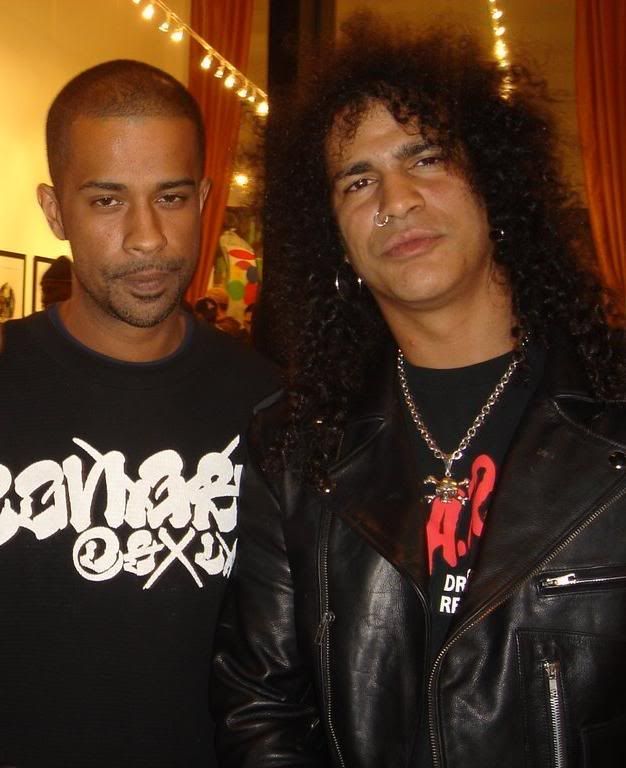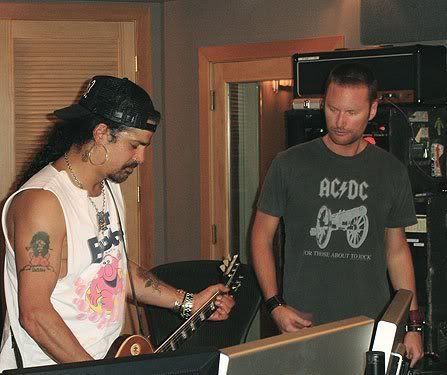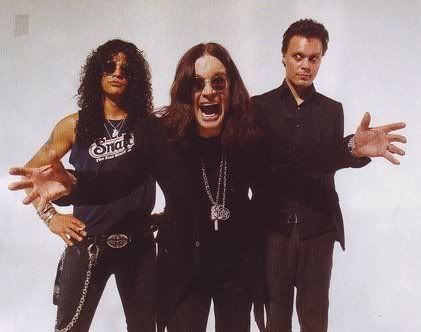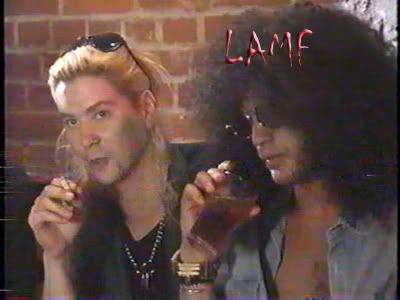jola pisze:SUNrise pisze:ewa pisze:Ash ma teraz takie włosy? Ostatnio jak go widziałam na zdjęciu około 17 lat temu :p to miał identyczną fryzurę jak Slash.
No to rzeczywiście dawno. Bo Ash już od lat loczków nie nosi. Ostatnio to sobie całkiem ściął włosy.
To jest zdjęcie sprzed 3 miesięcy (z października 2006)
Od lewej: Alex, w środku Ash (dla niewtajemniczonych - brat Slasha) oraz Slash

what?? to jest Ash??

no nieźle, w życiu bym go nie poznała...dobrze wiedzieć

:
Noooo tak. To jest brat Slasha, zawsze nim był i zawsze będzie.
Trzy linki, a propos powyższego zdjęcia:
>crewestgallery
>labelnetworks
>scottpower
Graffiti, Conart to jest coś, czym Ash się całe życie zajmuje, to jest coś co jego brat - Slash wspiera i popiera, przychodzi na wystawy prac no i podrzuca Ashowi czasem różne swoje pomysły np. wzorów, haseł na koszulki, które Slash później niejednokrotnie na sobie nosi.
(Ash trzeci od lewej)

A wrzucę Wam coś o Conart'ie. To jest wywiad z Ashem z maja 2003 roku (sorry, ale nie mam w tej chwili na tyle czasu żeby go tłumaczyć na pl.).
Recently I met up with Ash Hudson, the founder and owner of Conart's street wear/gear company. Finding the right time and place to meet for this interview with Ash was quite the challenge. He no longer has Conart's studio in LA which he and a staff of 12 occupied in the mid-1990s; nowadays he does most of his work done with his portable office, his laptop. I wasn't sure what to expect, but what I found was an innovative, laid-back and bright man who has taken the idea of graffiti and fashion to a whole new level.
Tell me about your company and give me the history of how Conart got started
Ash: Conart was started in 1989 with 100 dollars. I was 16 and was a graffiti artist. I saw the concept of applying graffiti; you tag it on anything, so here was the idea of tagging it on apparel. So this was one way to represent that this is what you were down with. If you were a punk rocker, you may have a Mohawk and this was just like creating the gear of the culture of hip-hop cause there was nobody catering to it at the time. I saw a friend of mine that was doing some really great art work and so I hired to him do a design under the name of Conart and printed it on 12 t-shirts and then gave them to my friends and that is how my company started.
Explain the name Conart.
Ash: It's kind of like a play on words we were con-artists and we would steal our supplies and vandalize the city streets, or beautify them, depending on the way you looked at it.
Where do you find the graffiti artists that you hire?
Ash: It is such a small community. It is word of mouth...if there is somebody great out there, there is a buzz. I feel we have established a rapport with the artists and they want to come to us. These kids are still looked at as vandals. They are borderline gangsters. They don't really have the respect in the art world that they are legitimate artists. They are looked at as these visual terrorists. There is a big difference between graffiti artists and gang members. Gang members are trying to claim a territory or neighborhood. Graffiti artists are trying to represent themselves; they are doing these full production murals that aren't just a tag and chicken scratch. There is a lot more artistic value to graffiti than there is just tagging. People stereotype it all as an eyesore. But there are the elite graffiti kids, who have chosen one of the hardest mediums to use to express themselves.
Tell me about some of the ConArtists that eventually worked for Conart?
Ash: Cisco and Mear are artists from CBS crew which is a local LA graffiti crew. There is also a graffiti artist named Tribe, she is a Chicana artist. She's not your typical graffiti artist in the sense that she is really sexy and not what you would expect. She is on some kind of graffiti black list. There is this task force out trying to sabotage graffiti artists and so the cops have raided her house twice, like kicking her door down, taking all of her graffiti supplies, her markers, her pens, her books, her photos, her computers. The reason being is that she did this graffiti on the window of this bus. They shot this cover for this graffiti magazine and as the bus pulls up, she jumps on the bumper and tags across the window, the bus driver floors it trying to like run her over. She jumps off, and they get this photo though, and they run it as the issue cover the next month. But I guess she had incriminated herself and the cops were kicking down her door and raiding her spot and so she has been having a rough time. But she is the realist in the game; to me she is my Tiger Woods.
What are examples of the messages they want to give out through their art?
Ash: Some of our stuff has been more subliminal than others. In the past, we were being a little too radical and hardcore. We were pushing the limits. I don't think we realized our influence that we had with the kids. Now I think we are being a little more responsible with the imagery that we are putting out.
Your clothing line is very successful in Japan, what makes the consumers there so interested in your work?
Ash: The Japanese market is fanatical for hip-hop and every nook and cranny of it they have explored and taken it to the fullest extent or limits. We were at the forefront of hip hop apparel and there weren’t a lot of companies prior to us, embracing hip hop. There was sportswear and surf wear, but nobody really pushing that this is street wear, black-owned, urban, ethnic hip hop based company. We didn't want a cat walk with models wearing our clothing. We would rather have a bunch of rappers M.C.ing, in our clothing. That seemed more real and what a fashion show that would be if these kids were doing that instead. I think the Japanese have been so influenced by American culture and we were the first. I really feel that we have paved the way for a lot of these other companies. We never really got a chance to over saturate and make billions of dollars, but I also think that is what has kept us so cutting edge and the longevity of our company that we started in 1989 and the market is bigger than it has ever been now.
What kinds of musical artists were you working with to promote Conart?
Ash: When we had the Conart studio, it had a reputation that if you were coming to LA you needed to come in and see our studio. Rappers and musicians like Tupac and Notorious B.I.G. would come in to LA would come thru our studio. As they would come, we would outfit them, take pictures of them, give them some clothes and then all the shows they would being doing, they would wear our stuff.
What are some of the big projects that you have done?
Ash: We did a lot of tour merchandise for bands. We were doing custom graphics and album covers. We would do the tour shirts and maybe design some pins, buttons or key chains and poster art. We got hooked up with some of the bigger merchandising companies who had the rights for Guns N' Roses, Motley Crue, Metallica and Rolling Stones so they would float us work from all those groups. We have also done work for AC/DC and Rancid.
Where you doing this merchandising as Conart or under a different name?
Ash: The tour merchandise were we doing was done for hire thru the merchandise company because we had a relationship with them and they knew we had a team of artists that could render designs for them pretty quickly, they would shoot us a lot of work, but they wouldn't be Conart pieces, they would be custom for-hire work. I didn't want our identity to be confused in the beginning when we were trying to establish our company. We were so new that it could hurt us as a company and that wasn't really the market we were trying to establish. We were trying to establish our hip hop roots and it could confuse the kids and loose its core-ness.
How has the company changed?
Ash: Now our t-shirt manufacturer's ship directly instead of us warehousing it and packing and shipping it. Now I don't have to hire kids to do it or have insurance, I do it all from the printers and manufactures and working straight from those facilities. So it has enabled me to free up and be a little more flexible so I am not locked down to one thing. I am able to do other projects.
It must be fun.
Ash: It is fun, though it is not easy. Being your own boss, it is hard knowing when to stop. I sleep, dream, and bleed Conart. It is overwhelming sometimes. I want so much for it. You want to compete with the Hilfiger's. I feel that Tommy Hilfiger is no more stylish than any accountant. He's been successful in the sense that they had infrastructure and they knew business and they had that behind them. But I don't think they have the first concept of what is really fashionable. It is just more of store filler, playing on gimmicks with the American flag logo, which to me is just Cross Colors American style. Very generic. Very swap meet style, mass produced.
Are you always looking for new stuff?
Ash: We are always looking for new stuff. I have a wealth of stuff I haven't put out yet because the stuff was coming in so rapidly. I have designs for the next 20 years. But to stay current I always need fresh stuff because styles change, you know there is war going on now, so there are new themes, new concepts to hit, styles, trends, and music's changed to maybe rap fusion. So now it might not just be a character of a DJ, but a DJ with a laptop doing Pro-tools. There are also new artists out... You always want to freshen it up.
What kind of clothing and gear is a part of the ConArt line?
Ash: Some of the things include t-shirts, denim apparel, nylon outer wear, snowboard gear. It is a fusion of all my influences, skateboarding, and hip hop, graffiti, and LA rebellion.
What stores carry your clothing line?
Ash: The website is the greatest promotion for us. We are in the process of a complete facelift and have all new content about to go up any day.
www.conart.com
Are there any other companies that have developed out of Conart?
Ash: In 1995, I partnered with one of my graffiti artists named Mear and we developed a sister company called Kaotic. We attempted to start it then, but it is just now starting to pick up. Its motivation is political, anti-political, anti-corporate conscious line. We are trying to put out some strong messages. This is a new collection that we have just gotten together and that is what's at the forefront. Mear was hired by a political bookstore to come and do this political protest piece on their wall a on the NE corner of Sunset Blvd and Alvarado. This is Kaotic. This is what Conart has led up to. Taking all of our experience and creating something new, a little more refined, not competition with Conart. Conart is hip hop, beat boy, graffiti, street wear. Kaotic is political protest riot gear.















 .
. 






























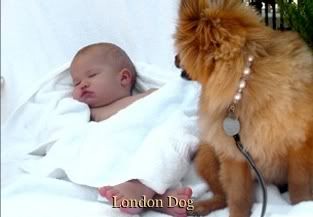
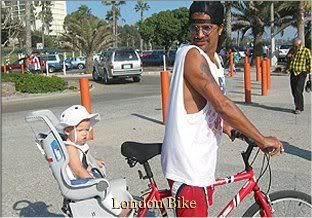 z tatą na rowerze
z tatą na rowerze